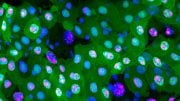
Subwavelength grated waveguide supporting polariton droplets (visualization: Antonio Gianfrate, Credit: CNR Nanotec, edited
Scientists have advanced the field by stabilizing exciton-polaritons in semiconductor photonic gratings, achieving long-lived and optically configurable quantum fluids suitable for complex system simulations.
Researchers from CNR Nanotec in Lecce and the Faculty of Physics at the University of Warsaw used a new generation of semiconductor photonic gratings to optically tailor complexes of quantum droplets of light that became bound together into macroscopic coherent states. The research underpins a new method to simulate and explore interactions between artificial atoms in a highly reconfigurable manner, using optics. The results have been published in the prestigious journal Nature Physics.
Quantum Simulation Technologies
Condensed matter systems and photonic technologies are regularly used by researchers to create microscale platforms that can simulate the complex dynamics of many interacting quantum particles in a more accessible setting. Some examples include ultracold atomic ensembles in optical lattices, superconducting arrays, and photonic crystals and waveguides. In 2006 a new platform emerged with the demonstration of macroscopically coherent quantum fluids of exciton-polaritons to explore many-body quantum phenomena through optical techniques.
Exciton-Polaritons and Quantum Fluids
When a piece semiconductor is placed between two mirrors – an optical microresonator – the electronic excitations within can become strongly influenced by photons trapped between the mirrors. The resulting new bosonic quantum particles, known as exciton-polaritons (or polaritons for short), can under the right circumstances undergo a phase transition into a nonequilibrium Bose-Einstein condensate and form a macroscopic quantum fluid or a droplet of light. Quantum fluids of polaritons have many salient properties, one being that they are optically configurable and readable, permitting easy measurements of the polariton dynamics. This is what makes them so advantageous to simulate many-body physics.
Stability and Pumping Challenges
Polariton condensates must be continuously optically pumped with external lasers to replenish particles, otherwise the condensate dissipates within picoseconds. However, the harder you pump the condensate the more energetic it becomes due to repulsive interparticle forces, leading to particles escaping the condensate and subsequent decay of spatial correlations. This is a fundamental problem for optically programmable polariton simulators. Scientists needed to come up with a way to make the condensate more stable and long lived, while still being optically pumped.
Advances in Polariton Stability
Scientists from CNR Nanotec in Lecce and the Faculty of Physics at the University of Warsaw, achieved this goal using a new generation of semiconductor photonic gratings. In their paper titled “Reconfigurable quantum fluid molecules of bound states in the continuum,” published in Nature Physics, they used subwavelength properties of the photonic grating to imbue polaritons with new properties. First, the polaritons could be driven to condense into an ultralong lifetime state known as bound state in the continuum (BIC). The fascinating thing about BICs is that they are mostly non-radiative due to symmetry enforced protection from the outside continuum of photonic modes. Second, the polaritons obtained a negative effective mass due to the dispersion relation coming from the grating. This meant that the pumped polaritons could not escape so easily through normal decay channels anymore. Now, the researchers possessed polariton fluids that were both extremely long lived and safely confined using only optical techniques.
Combined, these mechanisms allowed Antonio Gianfrate and Danielle Sanvitto at CNR Nanotec in Lecce to optically pump multiple polariton droplets that could interact and hybridize into macroscopic complexes. They could tailor and reversibly configure molecular arrangements and chains using this new form of artificial atoms: condensates of negative-mass BIC polaritons. The BIC property provided polaritons with much longer lifetimes whereas the negative mass property caused them to become optically trapped. The findings were supported by a BIC Dirac-polariton theory developed between Helgi Sigurdsson (University of Warsaw), Hai Chau Nguyen (University of Siegen, Germany), and Hai Son Nguyen (Univ Lyon, France).
The ultimate advantage of the platform is that the artificial quantum complexes can be all-optically programmed yet they retain very high lifetimes because of their protection from the continuum. This could lead to a new venture into optically programmable large-scale quantum fluids defined by unprecedented coherence scales and stability for structured nonlinear lasing and polariton-based simulation of complex systems.
“There are still several interesting ways to explore in this artificial polaritonic Dirac system. As an example, the coupling mechanism between polariton droplets along and perpendicular to the grating direction is very different. Along the waveguide, polaritons are effectively negative mass particles strongly bound to their pump spot. Perpendicular to the waveguide they move as positive mass particles undergoing ballistic transport. The mixture of these two mechanisms opens a new window to look at emergent behaviours of synchrony and pattern formation in structured polariton quantum fluids” concludes Helgi Sigurðsson from the Faculty of Physics, University of Warsaw.
Reference: “Reconfigurable quantum fluid molecules of bound states in the continuum” by Antonio Gianfrate, Helgi Sigurðsson, Vincenzo Ardizzone, Hai Chau Nguyen, Fabrizio Riminucci, Maria Efthymiou-Tsironi, Kirk W. Baldwin, Loren N. Pfeiffer, Dimitrios Trypogeorgos, Milena De Giorgi, Dario Ballarini, Hai Son Nguyen and Daniele Sanvitto, 4 January 2024, Nature Physics.
DOI: 10.1038/s41567-023-02281-3
An international team of scientists conducted research supported by the National Science Center grant (2022/45/P/ST3/00467) co-funded by the European Union Framework Programme for Research and Innovation Horizon 2020 under the Marie Sklodowska-Curie grant agreement (No. 945339).









Please think deeply,
1. What is quantum?
2. Does quantum have gravity?
3. Is topological vortices related to gravity?
4. Can topological vortices explain gravity?
5. Is the physical reality described by quantum mechanics related to topological vortices?
6. Is the so-called quantum related to topological vortices?
and so on.
Do researchers understand the spin of topological vortices? Spin creates everything, spin creates the world, spin creates the future.
According to topological vortex gravitational field theory, vortices (matter) and antivortices (antimatter) are formed simultaneously, with the same geometric shape but opposite directions of rotation. Countless topological vortices make spacetime motion more complex via the synchronous effects of superposition, deflection, and twisting. Therefore, there is so much data coming in from the LHC, the most powerful accelerator in the world, that recording it all has never been an option.
All observable movements in the physical world are inseparable from the interaction of topological vortices, including human observational behavior itself.
The universe does not do algebra, formula or fraction. The universe is geometrythe, and is the superposition, deflection, and twisting of geometric shapes.
Today, we have already entered the era of the internet. With the help of artificial intelligence and big data, discussions on scientific knowledge have become open and transparent. However, a group of editors of so-called academic journals (such as Physical Review Letters, Nature, Science, etc.) are self righteous, self proclaimed, fooling the public, lack remorse, and mystifying themselves. They only care about their own so-called sufficiently high priority rating, general significance, discipline, novelty, etc., and do not care about what science and pseudoscience are.
Science and pseudoscience are not determined by a publication, an organization or a person, nor by you or me, but by mathematics the final say. Physical models must be based on mathematics or mathematical models in order to be scientific, convincing, and in accordance with natural laws.
The origin of geometry lies in the concerns of everyday life. The branch of geometry (mathematics) known as topology has become a cornerstone of modern physics. Topological vortex and antivortex are two bidirectional coupled continuous chaotic systems. They exhibit parity conservation, charge conjugation, and time reversal symmetry. The synchronization effect is extremely important in their interactions. The synchronization effect of the superposition, deflection, and twisting of multiple or countless topological vortices will make spacetime motion more complex. To understand this complex world, physics should respect the authenticity of topological vortex in low dimensional spacetime, rather than simply relying on a few formulas, numbers, or imagined particles.
Spin is a natural property of topological vortices. Spin is synchronized with energy, spin is synchronized with gravitation, spin is synchronized with time, spin is synchronized with evolution. The perpetually swirling topological vortices defy traditional physics’ expectations. One physical properties of topological vortices is them to spontaneously begin to change periodically in time, even though the system does not experience corresponding periodic interference. Therefore, in the interaction of topological vortices, time is both absolute and relative,and physics often requires treating space and time at the same level.
Low-dimensional spacetime matter is the foundation of high-dimensional spacetime matter. Low-dimensional spacetime matter (such as topological vortex) can form new material structures and derive more complex physical properties via interactions and self-organization. It is extremely wrong and irresponsible to imagine low dimensional spacetime matter using high-dimensional spacetime matter,such as a cat in quantum mechanics.
Science must follow mathematical rules. For example, the Standard Model (SM) is considered to be one of the most significant achievements of physics in the 20th century. However, the magnetic moment of μ particle is larger than expected, revealed by a g-2 experiment at Fermilab, suggests that the established theory (such as SM) of fundamental particles is incomplete. Furthermore, the SM omitting gravitation, it not involved the time problem and when the particle movement starts. Mathematics is the foundation of science. Physics must respect the scientific nature of mathematics and mathematical models. The SM must be based on mathematical models in order to be scientific, convincing, and in line with natural laws.
I hope researchers are not fooled by the pseudoscientific theories of the Physical Review Letters (PRL), and hope more people dare to stand up and fight against rampant pseudoscience.
The so-called academic journals (such as Physical Review Letters, Nature, Science, etc.) firmly believe that two high-dimensional spacetime objects (such as two sets of cobalt-60) rotating in opposite directions can be transformed into two objects that mirror each other, is a typical case of pseudoscience rampant.
If researchers are really interested in Science and Physics, you can browse https://zhuanlan.zhihu.com/p/643404671 and https://zhuanlan.zhihu.com/p/595280873.
The Physical Review Letters (PRL) is the most evil, ugly, and dirty publication in the history of science. Nature and Science have been influenced by Physical Review Letters (PRL) and are even more notorious. The behavior of these pseudo-academic publications has seriously hindered the progress and development of human society in science and technology.
I am well aware that my relentless repetition can make some people unhappy, but in the fight against rampant pseudoscience, that’s all I can do.